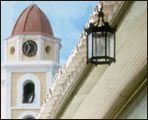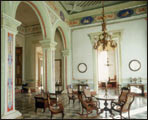Trinidad is considered
the Museum city of Cuba and for this reason, in 1988, Unesco
declared Trinidad  and
the Valle de Los Ingenios "World Heritage". and
the Valle de Los Ingenios "World Heritage".
The Plaza Mayor is the central axis of the old city and
historic center of Trinidad. It holds peculiar construction
in which the unevenness of the land is corrected. The centre
shelters the statue of Terspsicore, a dance and music muse,
and from that point the beautiful constructions of the city
can be appreciated.
In the upper left part of the Plaza Mayor is the Brunet
Palace, today's Museo Romantico of Trinidad the architecture
representing the main principles of the XIXth century, numerous
colonial work of art such as paintings, glassware from Bohemia,
european amphoras, Talavera de la Reina ceramics, china,
gold and silver crafts, precious wood furniture decorated
with romantic and baroque style can be admired.
Next to the Palacio Brunet is the Parroquial Mayor, a neo-classic
construction that was completed in 1892. The Parish holds
the beautiful statue of Cristo de Veracruz that was carved
in Spain in the XVIIIth century. A neo-gothic altar made
out of precious wood and dedicated to Santisima Trinidad
can also be seen. Although it does not have the same luxury
of other churches, visiting the Parroquial Mayor is of utmost
importance. It holds a Carrara marble altar  dedicated
to the Virgen de la Misericordia, the only one in the country. dedicated
to the Virgen de la Misericordia, the only one in the country.
A visit to la Casa Padron, residence of Don Antonio Padron
who was one of the richest man in Cuba, is a must. The Condes
de San Antonio later lived in the house. La Casa de Alderman
Ortis which dates back to 1809 belongs today to the Fund
for Cultural Goods and holds a permanent art galery of painters
such as Antonio Herr and Juan Olivia. La Casa de los Sanchez
Iznaga - dating back to the XVIIth century is, today, the
Museum of Arts and Construction Techniques of the colonial
era. The Palace Cantero, completed in 1827 hosts the Municipal
History Museum. La Casa de la Musica illustrates the development
of the Trinidadian music and an ideal place for remembering
the master pianist Felo Bergaza (important Cuban pianist)
and Lico Jimenez (director of the Hambourg Conservatory
between 1890 and 1917). The church and convent San Francisco
de Asis is, today, the Museum of La Lucha Contra Bandidos
(fight against bandits) ; el Parque Carrillo, Las Tres Cruces
and the Templo de Yemaya are also of great interest.
|